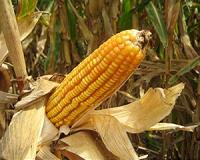 |
Madison WI (SPX) Jun 30, 2010 A one-time tillage has no adverse effects on yield or soil properties on no-till land, according to field research conducted at the University of Nebraska-Lincoln. Although tillage is another expense for farmers and generally increases the risk of soil erosion, a one-time tillage may be performed to correct some problem, such as a perennial weed problem. The feasibility study was conducted for five years at two locations in eastern Nebraska. Charles Wortmann led the interdisciplinary team in examining the effects of a one-time tillage on no-till land for grain yield, reducing stratification of soil properties, increasing soil organic matter, and improving soil physical properties. The results were published in the July-August 2010 edition of Agronomy Journal. Continuous no-till crop production has been widely adopted for reduced fuel consumption and labor requirement, erosion control, improved surface soil properties, increased profitability, and often increased yield. Crop yields have generally increased in the western and southern parts of the U.S., although northern agricultural lands have seen some declines in yield. Nebraska occupies a transition zone, with little change in yield due to no-till. The researchers were testing whether one-time tillage of no-till could help manage certain perennial weeds, and reduce phosphorus stratification and runoff. They also wanted to determine if a one-time tillage, by burying the enriched surface soil and bringing deeper, less improved soil to the surface, improve soil structure and the distribution of soil nutrients. Tillage did reduce stratification of phosphorus, soil organic matter and soil bulk density for the first years, but by the end of the five year experiment there was no difference between one-time till and no-till treatments. One-time tillage had no effect on soil organic matter content in the surface one foot of soil after five years. One possible negative effect of tillage was reduced microbial biomass at one site, but it did not affect grain yield. The study areas consisted of one plot of grain sorghum rotated with soybean and corn with soybean at the other location. Tillage treatments included deep plowing with moldboard plows or a mini-moldboard plow, and disk tillage, and was done in late fall or very early spring to have low soil temperature and microbial biomass preceding and following tillage to minimize soil organic matter losses. The authors concluded that one-time tillage of no-till can be done in eastern Nebraska without measureable long-term effects on yield or soil properties except for a change in soil microbial communities. Since tilling increases erosion risk, the authors recommend tilling only to address problems that cannot be cost-effectively managed with no-till practices.
Share This Article With Planet Earth
Related Links American Society of Agronomy (ASA) Farming Today - Suppliers and Technology
 Maize Prices Driving A Rise In Feed Prices
Maize Prices Driving A Rise In Feed PricesBeijing, China (SPX) Jun 30, 2010 Himfr reports that in 2009, maize transaction prices dropped to their lowest in two years, at 1,330 RMB per ton. While from March of this year, maize prices began sharply rising, with a rise from 1,762 RMB to 2,000 RMB per ton. In the non-producing areas of Jiangsu and Sichuan, corn prices have already reached 2,010 RMB / ton. China is not experiencing a shortage of maize. The rise in pric ... read more |
|
| The content herein, unless otherwise known to be public domain, are Copyright 1995-2010 - SpaceDaily. AFP and UPI Wire Stories are copyright Agence France-Presse and United Press International. ESA Portal Reports are copyright European Space Agency. All NASA sourced material is public domain. Additional copyrights may apply in whole or part to other bona fide parties. Advertising does not imply endorsement,agreement or approval of any opinions, statements or information provided by SpaceDaily on any Web page published or hosted by SpaceDaily. Privacy Statement |